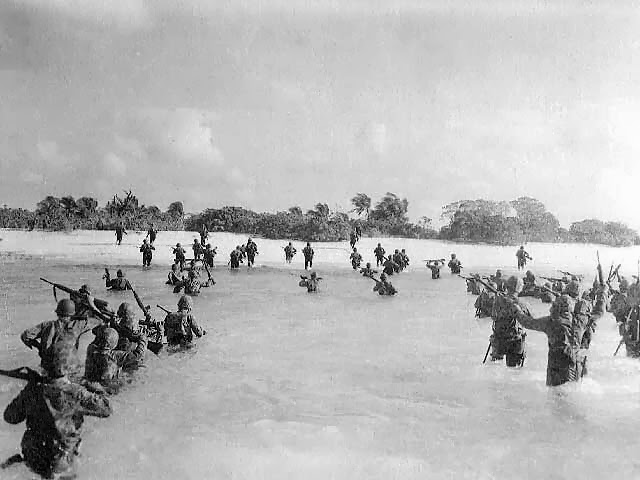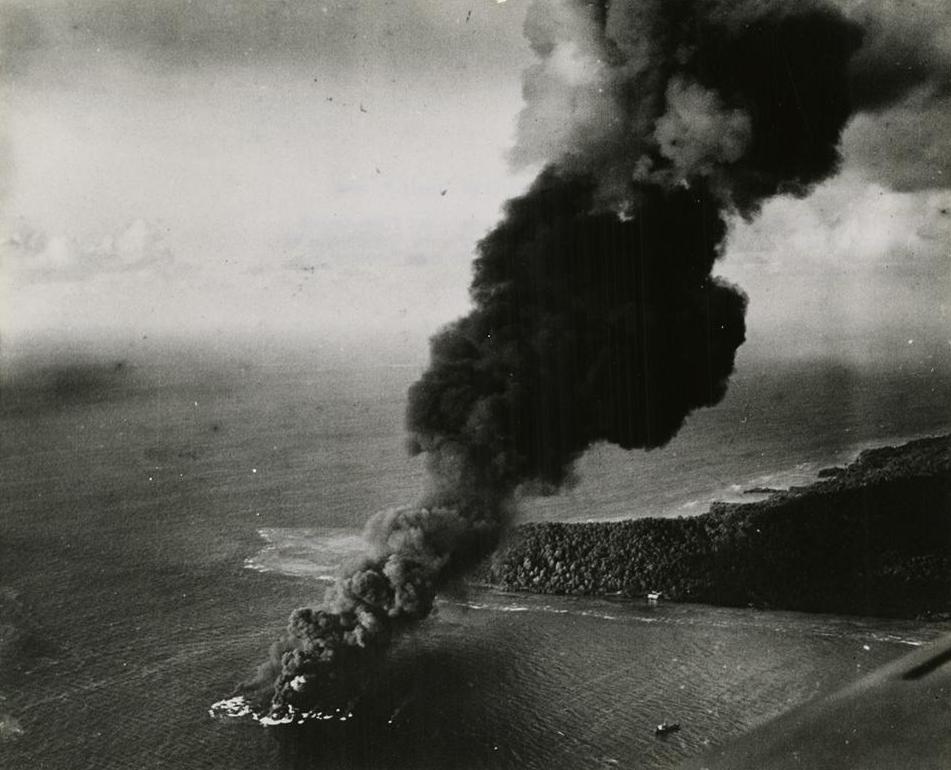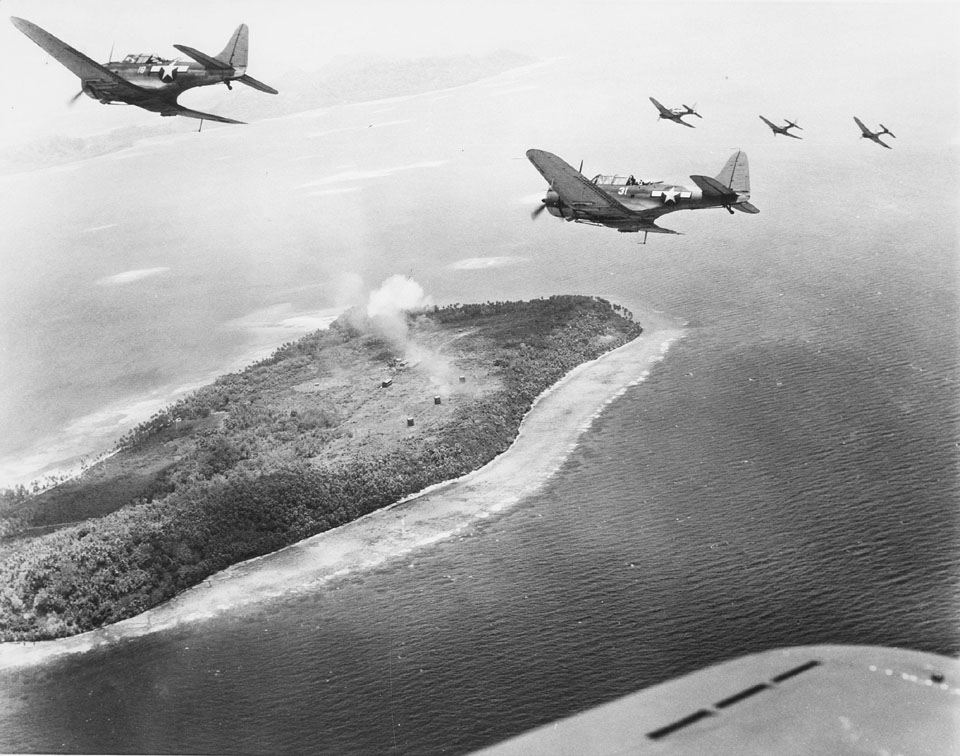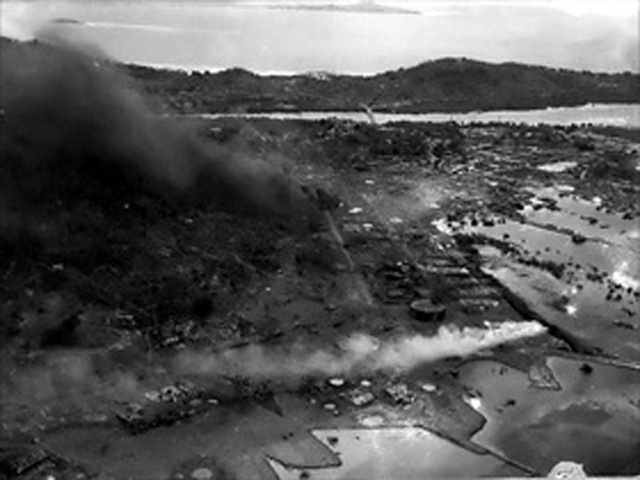Air Operations, Bismarcks
- 70 AirSols TBFs and SBDs escorted by more than 40 AirSols fighters attack shipping in Keravia Bay.
- VMF-217, VMF-222, and VF-17 F4Us down 9 A6M Zeros and 1 Ki-43 'Oscar' fighter over the Rabaul area between 0830 and 0905 hours. 2 F4Us are lost.
- 40 V Bomber Command B-24s attack the Panapai airfield on New Ireland and Talasea. 16 B-25s attack a submarine and two ships off New Hanover.
- ;During the night, US destroyers coached by airborne observers aboard Navy PB4Ys bombard Rabaul and Kavieng at close range.
Air Operations, Carolines
- Beginning with a dawn strafing attack by 72 F6Fs, US carrier aircraft from Task Force 58 support Operation CATCHPOLE, the impending invasion of Eniwetok Atoll, by mounting powerful attacks against the Japanese Navy regional base at the Truk Atoll. TBMs, SBDs, SB2Cs, and F6Fs damage or destroy as many as 150 aircraft on the ground and attack 4 Japanese warships and as many as 50 transports and other vessels in the lagoon.
- While supporting carrier-based SBDs and TBMs, as well as conducting their own strafing attacks against all manner of targets, F6Fs down 121 Japanese Navy aircraft, mostly A6M Zeros. A VT-9 TBFM gunner also downs 1 A6M. This is the highest one-day victory total so far in the Pacific War. 4 F6Fs are lost in the action.
- VII Bomber Command B-24s attack Ponape and Kusaie islands.
- During the night, 6 radar-equipped B6N 'Kate' torpedo bombers mount an unopposed attack against Task Force 58, and 1 torpedo hit is scored on the fleet carrier USS Intrepid, which retires to the Majuro Atoll.
- Also during the night, 12 VT-10 TBMs armed with 500-pound bombs mount the war’s first carrier-based night radar attack against shipping in Truk Lagoon. Several hits are claimed and several ships are apparently sunk.
Air Operations, CBI
BURMA- 2 490th Medium Bomb Squadron B-25s and 6 10th Air Force P-51s attack a road bridge and rail facilitues in the Pyingaing area. 2 B-25s and 6 P-51s attack a bridge near Ye-u. 28 P-51s and A-36s attack Japanese Army ground troops and supply dumps between Lonkin and Kamaing. 2 P-51s attack a road junction near Maingkwan. 6 P-51s attack supply dumps around Lonton and Manywet.
- 4 341st Medium Bomb Group B-25s attack a freighter near Vinh, a bridge, and 2 locomotives.
Air Operations, Europe
There are ceaseless Allied raids on the German spearheads at Anzio. More than 1,000 tons of bombs are dropped by Allied planes as part of a massive bombardment to prevent a German breakthrough to the sea at Anzio. Naval gunfire and artillery barrages help contain the Germans who had driven a wedge into the center of the US 45th Div.
US 12th AIR FORCEITALY:
- Allied naval bombardment and air attacks, including more than 800 medium and heavy bomber sorties, help prevent the German Army counterattack from breaking into the Anzio beachhead area. The 12th Air Force is fully engaged in turning back the German Army counterattack against the beachhead, and all types of aircraft, including 15th Air Force fighters and fighter-bombers, are employed in direct and close-support tactical missions as well as attacks on German Army lines of supply and communication. Also, unescorted 15th Air Force heavy bombers attack motor-vehicle parks, troop concentrations, and storage dumps.
- In the day's only air action in support of the US 5th Army, XII Air Support Command A-36s attack the Monte Cassino Monastery.
Air Operations, Marshalls
- The landing phase of Operation CATCHPOLE, the invasion of the Eniwetok Atoll (originally scheduled to take place in May), begins with intense air and naval bombardment. US Marine reconnaissance and scout troops secure outlying islands without opposition.
- VII Bomber Command B-24s attack the Jaluit Atoll, and 15th Fighter Group P-40s attack Japanese Navy floatplanes in the Jaluit Atoll.
- Escorting and supporting the Eniwetok invasion fleet and providing pre-landing and on-call air support are the carrier aircraft of Task Group 58.4 and Task Group 53.6. [See February 16, 1944.]
Air Operations, New Guinea
16 V Fighter Command P-47s attack targets of opportunity around Alexishafen.
[Air Operations, Solomons
VMF(N)-531 PVs down 2 E13A 'Jake' reconnaissance float planes in the Green Islands at 0210 and 0330 hours, respectively.
[Bismarcks
During the night American destroyers bombard Rabaul and Kavieng. Each of these ports is shelled twice more later in the month on nights chosen to coincide with other operations, particularly the landings on Los Negros.
[Caroline Islands
Vice-Adm Spruance's formidable Task Force 58, which, although incomplete since the group engaged on the Eniwetok landing has been detached, still counts 9 aircraft carriers and 6 battleships, attacks installations and shipping at Truk. American bombers and torpedo-planes cause tremendous damage. 265 Japanese aircraft are destroyed on the ground or in combat among which were 200 designated to be moved to Rabaul for reinforcement there. The light cruiser Naka, the training cruiser Katori, the destroyer Maikaze, the destroyer Oite, the destroyer Tachikaze and some 30 other ships including 5 tankers are sunk. The airfields and port installations are disrupted. The Americans lose only 25 aircraft and the aircraft carrier Intrepid (CV-11) is damaged during the night by an enemy torpedo plane. In their night counterattack the Japanese lose another 31 aircraft. The battleships Iowa (BB-61) and New Jersey (BB-62) intercept the light cruiser Katori and a destroyer which escaped from the first attack on Truk, and sink them.
[Eastern Front
The battle of the Korsun pocket comes to an end when the bulk of the surviving German forces reach their own lines. Of Gen Wilhelm Stemmermann's original force of 56,000, 35,000 have escaped but with little equipment. Stemmermann is himself killed. All of the 6 divs involved are totally unfit for further operations for the moment, leaving von Manstein even more desperately short of manpower.
A special Order of the Day announces the liquidation of the Korsun-Shevchenkosky pocket. According to the Soviet announcement the Germans have lost 100,000 men although Marshal Konev's memoirs give 55,000 German dead and 18,200 prisoners. A substantial haul of arms and ammunitions falls into Russian hands. The next day, in Moscow, the great victory is celebrated by the firing of 12 salvos of 224 guns.
SOUTHERN SECTORGroup Stemmerman begins to link up with the III Panzer Corps. Hundreds have been killed on the march though, freezing to death as they try to cross the icy Gniloy Tikich or falling under Russian fire. Among the casualties is Stemmerman, who is killed as his force reaches safety. Realizing that the Germans were escaping, the 2nd Ukrainian Front launches an all-out attack upon the pocket, striking the 57th and 88th Infantry Divisions hard.
[Green Islands
The New Zealanders continue 'cleaning up' the islands, while a base for US motor torpedo boats is made effective.
[Italy
In the US 5th Army's VI Corps area, the Germans commit their full strength to the counteroffensive. Pressing down the Albano road, the Germans drive a deep wedge into the center of the 45th Division front, between the 157th and 179th Regiments. Allied aerial, artillery, and naval bombardment is helpful in preventing an enemy breakthrough. The air effort is the heaviest yet undertaken in support of the troops with about 1,100 tons of bombs being dropped. The British 1st Division (-- 3rd Brigade) is given the task of holding the sector of the final beachhead line in the Albano road area in order relieve the pressure on the 45th Division. The 45th Division is reinforced by the 2nd Battalion of the 6th Armored Infantry. The British 56th Division recovers ground previously lost to the enemy in its sector. Gen Truscott, relieved of Command of the 3rd Division by Brig-Gen John W. O'Daniel, becomes deputy commander of the VI Corps.
In the New Zealand Corps area, elements of the Indian 4th Division make a night assault in the Cassino area and reach the crest of Hill 593 but are driven off. Reinforcements move up and occupy the heights between Points 450 and 445. The British 78th Division, having been delayed by deep snow, arrives in the New Zealand Corps zone from the British 8th Army front. Planned air support is again shifted to Anzio.
The remaining monks at Monte Cassino are evacuated by the German military authorities and taken to Rome.
[Marshalls
ENIWETOK ATOLLAdm Harry W. Hill's Eniwetok Expeditionary Group (TF 51.11) invadest the Eniwetok Atoll (Operation CATCHPOLE) after preliminary naval gunfire, air bombardment, and minesweeping operations. Troops of the V Amphibious Corps' Reconnaissance Company make unopposed landings from the lagoon side of Canna (Rujoru) and Camellia (Aitsu) Islands, southeast of Engebi, at 1318. A quick search reveals no Japanese and artillery is brought ashore and registered on Engebi, the main objective in the northern part of the atoll. In order to insure the safety of the artillery units VAC scouts then take several small islands in the vicinity of Canna and Camellia without any enemy interference. 4th Marine Division scouts, of Company D, 4th Tank Battalion, head for Zinnia (Bogon), west of Engebi, to block any withdrawal from Engebi. In the darkness they land by mistake on 2 islands below there but work back to Bogon without opposition. The first day's objectives are thus secured without any American casualties. In preparation for the invasion of Engebi, naval gunfire supplemented by shore-based artillery fire is placed on the island and underwater demolition teams reconnoiter the beaches.
There are 3 battleships, Pennsylvania (BB-38), Colorado (BB-45) and Tennessee (BB-43) and 3 escort carriers in the supporting force. The total Japanese garrison of the islands is about 3,400 men, led by Gen Yoshima Mashida, mostly concentrated on Eniwetok and the neighboring islet of Engebi. The tactics are the same as those so successful at Kwajalein: the occupation of objectives smaller and less strongly defended that the main objective and the landing on them of guns which can hammer the main objective and support operations on it.
Having sited their guns on the islets of Rujoru and Aitsu, the Americans begin to bombard Engebi from the air, sea and land. During the night groups trained in the demolition of underwater obstacles approach the beaches chosen for the landing.
[Mediterranean
The cruiser HMS Penelope is torpedoed by U-410 off Anzio. The ship does not survive a second attack delivered the next day.
[Pacific
- The Japanese minesweeper No. 26 is sunk by aircraft off Rabaul, New Britain.
- The US destroyer Nicholas (DD-449) sinks the Japanese submarine I-11 in the Marshall Islands area.
- The Japanese submarine chaser No. 24 is sunk by the US destroyer Burns (DD-588).
- The US submarine Cero (SS-225) sinks the Japanese transpsort Jozan Maru between Truk and New Ireland.
- The US submarine Sargo (SS-188) attacks a Japanese convoy about 150 miles northeast of Palau and sinks the ammunition ship Nichiro Maru (6534t).
- The US submarine Tang (SS-306) attacks a Japanese convoy about 130 miles west-northwest of Truk and sinks the army cargo ship Gyoten Maru (6854t) and the merchant tanker Kuniei Maru.
Unitd States, Home Front
A bomber crashes into Navy barracks in San Diego, California causing 34 casualties.
[Images from February 17, 1944
|
|
|
|
|
|
|
|







